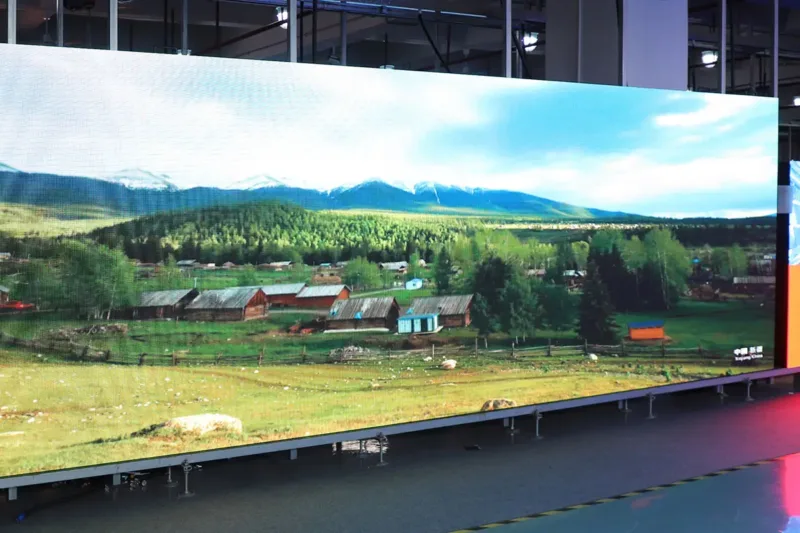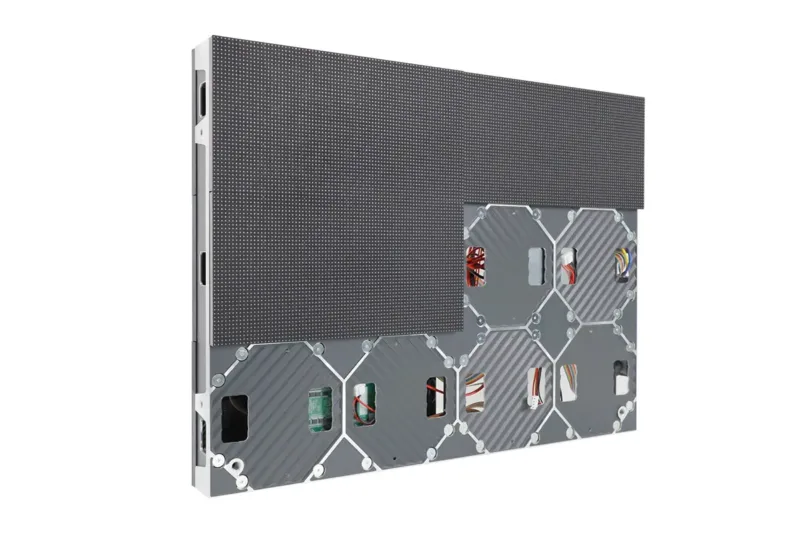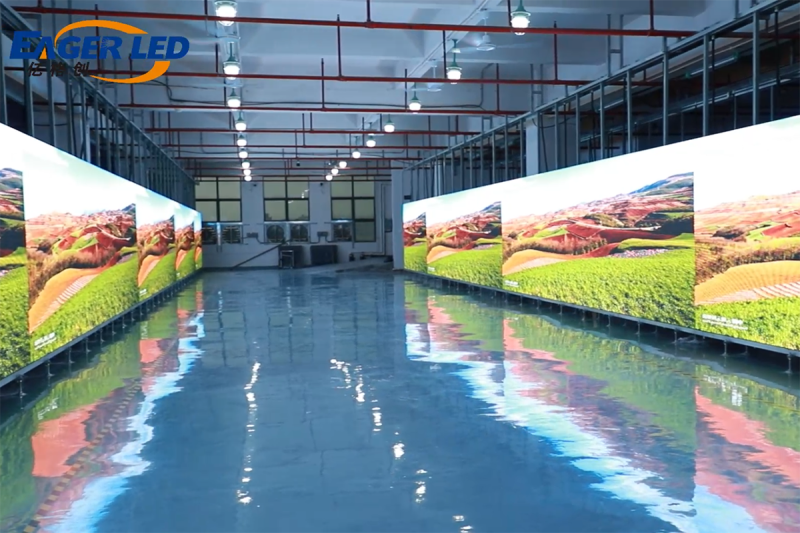Every EagerLED rental LED screen is engineered for event professionals: ultra-light 16mm panels deliver 4K resolution without compromising durability, whether it’s a stadium concert or pop-up exhibition.
Categories
2025 New LED Display Price for You
Fill in the information and get your LED screen budget immediately!
Rental LED Screen Buyer’s Guide: Everything You Need to Know
Are you planning an event but struggling to create the most impressive visual experience on a tight budget? A Rental LED screen might be just what you need — it’s cost-effective and flexible. From indoor meetings to outdoor shows, one screen can be used many times and fit different needs.
But renting an LED screen is not just about “picking the biggest” or “choosing the cheapest.” What pixel pitch should you go for? Should you choose a standard rental LED video wall or a smaller model? How can you avoid installation disasters? These details are key to your event’s display plan. Below, I’ll guide you step-by-step on how to dodge the common traps and pick the right rental LED display for you.
catalogue
- 1. Che cosa è uno schermo LED a noleggio?
- 2. Vantaggi del noleggio di uno schermo LED per eventi
- 3.5 Tipi di schermi LED a noleggio per i tuoi eventi
- 4. Quando hai davvero bisogno di un display LED a noleggio?
- 5. Analisi dei costi del noleggio di schermi LED
- 6. Come scegliere lo schermo LED a noleggio più adatto al tuo evento?
- 7. Perché il produttore di schermi LED EagerLED è la scelta migliore per te?
- 8. Come installare un videowall LED a noleggio?
- 9.Domande frequenti
- 10.Conclusion
1.What is a Rental LED Screen?
A Rental LED screen actually looks quite similar to a fixed LED display, but the main differences are in the installation method and the usage scenarios. Rental LED screen is designed specifically for short-term events, touring shows, exhibitions, weddings, and other occasions that require frequent setup and teardown. Compared to a fixed screen, it is usually thinner and lighter, with design and structure focused on convenience.
The main differences between rental LED screen and fixed LED screen are:
Modular cabinet design: Each cabinet is equipped with a quick-lock mechanism, allowing it to be quickly assembled and disassembled like building blocks. This significantly improves setup efficiency.
Lightweight materials: Most rental screens use aluminum alloy frames, offering enough strength while reducing weight, making it easier to carry and transport.

Flexible installation options: Rental LED screen supports various setups like hanging or stacking, making it suitable for stage backgrounds, concerts, press events, exhibition booths, and more.
Convenient maintenance design: Rental screen typically supports front maintenance or quick module replacement, which makes troubleshooting and repairs quicker during events, minimizing downtime.
Transportation and protective design: To handle frequent transport, rental screens often have anti-collision designs at the corners of the cabinets and come with flight cases, making storage and transportation more convenient.
2.Benefits of Renting a LED Screen for Events
The biggest advantage of renting a LED screen is that you get a flexible and efficient visual solution at a lower cost.
Renting avoids the high costs of purchasing and prevents the issue of unused equipment. Take the P3.9 LED screen as an example: the daily rental cost is only about 1/20 of the purchase price, and it usually includes transportation, installation, and technical support services. This model is especially suitable for small to medium-sized event organizers with limited budgets and low usage frequency.
When it comes to technology updates, renting means you can always use the latest models of LED screens. Whenever a new project comes up, simply rent the latest screen and enjoy the newest display technology and better visual effects. Buying fixed equipment, on the other hand, may lead to issues like rapid tech updates and depreciation.
As for service support, professional LED screen manufacturers or rental companies typically provide full-service support, from transportation and installation to on-site setup, and even send professional engineers to assist with guidance.
3.5 Rental LED Screen Types for Your Events
These days, there are many types of LED screens available for rent, so you don’t have to worry about being too limited by rental options. Here are the most popular rental LED screens:
Outdoor LED Screen
Outdoor LED screens are designed specifically for outdoor events, with higher brightness and protection levels compared to regular screens.
- Brightness can reach 5000–7000 nits, ensuring a clear display even in direct sunlight.
- They are IP65 rated or higher for water and dust resistance, so no need to worry about rain damaging the screen during the event.
- Common pixel pitches are P3.9, P4.8, and P6.25, which are larger and better for long-distance viewing.
- EagerLED EA500C6,EA500H9

Small Pitch Indoor LED Display
If your event is indoors, it’s not recommended to use outdoor screens. Instead, choose professional indoor LED screens. These have smaller pixel pitches (common ones are P2.6, P2.9, P3.9), offering fine picture quality and support for 4K or 8K video playback.
They’re perfect for indoor events like conferences, weddings, exhibitions, and brand launches. Even up close, the image will remain clear without pixelation.

Flexible LED Screen
Want something more creative for your rental LED screen? Try a flexible LED screen. This type of screen uses flexible PCBs and soft modules, so it can be bent and arranged into curved, cylindrical, wave-like shapes, or any other creative design.
Plus, flexible LED screens are lightweight and thin, making installation and teardown super easy — perfect for your temporary needs.
Big rental LED Video Wall
If you want to create a huge, impressive visual effect at your event, a big LED video wall is the way to go. These are commonly used for stage backgrounds, and their massive size is one of the best tools for grabbing audience attention.

Trailer LED Screen
A trailer LED screen is a mobile LED display with its own trailer. The biggest advantage is that it’s “ready to go wherever you need it.” No complicated setup is required; just drive it to the event site, and it’s good to go. This makes it perfect for touring shows or mobile advertising.
4.When Do You Really Need a Rental LED Display?
Many event planners face a practical question: when is it more cost-effective to rent a LED screen instead of buying one?
4.1 When to Rent a LED Screen
If your event is a one-time or low-frequency occurrence, like a wedding, press conference, anniversary celebration, or roadshow, renting a LED screen is clearly the better option. Renting allows you to get a flexible visual solution at a lower budget and enjoy services like transportation, installation, setup, and technical support from the LED screen manufacturer.
Short-term event needs: For one-time or low-frequency events like concerts, exhibitions, weddings, and corporate annual meetings, renting is more cost-effective and there’s no need to bear long-term maintenance costs.
Need the latest technology but with a limited budget: LED technology advances quickly (upgrading every 2-3 years), and renting ensures that you can use the latest models (such as Mini LED or 8K ultra-high-definition screens) for every event. This helps avoid the risk of equipment becoming outdated, like old screens lacking brightness or outdated interfaces.
Complex venue or installation conditions: Temporary stages, outdoor locations, etc., that require quick setup and teardown. Rental companies provide professional installation teams, so you avoid the risk of mistakes when setting up yourself.
4.2 When to Buy an LED Display
However, if you are an event company, advertising media company, or have long-term and frequent needs—like regularly setting up stages, hosting exhibitions, or running outdoor advertisements—buying your own LED screen is more economical and gives you more freedom in the long run.
High-frequency use: For long-term needs like mall advertising screens, conference centers, or permanent stages, buying is more economical. Although the upfront investment is higher, the lifespan of the equipment is typically 5-8 years. If you’re renting frequently, the total rental cost over a few years can end up being much higher than purchasing.
Strong customization needs: If you require special sizes, fixed installations (like building facade screens), added custom frames, unique shapes, or integrated interactive features, rentals are usually limited in these aspects. Rental products are often designed to meet the general needs of most clients, so customization is typically restricted.
5.Rental LED Screen Cost Analysis
The cost of renting a LED screen doesn’t have a fixed standard; it varies depending on factors like screen size, pixel pitch, brightness, rental duration, and additional services. Generally speaking, the daily rental fee can range from $500 to $15,000.
5.1 Impact of Screen Size on Price
The larger the screen, the higher the cost:
- Small screens (about 1–2㎡): Daily rental is around $500–$1500, suitable for meetings, exhibition booths, and retail events.
- Medium screens (about 5–10㎡): Daily rental is around $800–$2500, commonly used for corporate annual meetings, stage events, and exhibitions.
- Large screens (over 20㎡): Daily rental starts from $3000, and high-definition large screens can even exceed $8000, typically used in stadiums, concerts, and music festivals.
5.2 Resolution and Pixel Pitch
The smaller the pixel pitch, the clearer the image, and the higher the price:
- High resolution (P2/P3): For example, a 100-square-foot P3 screen costs around $1500–$3000 per day to rent.
- Standard resolution (P6): For the same size, a higher pixel pitch means a more affordable price, typically around $800–$2000 per day, suitable for long-distance viewing.
5.3 Rental Duration
Most rental companies offer quotes based on “full price for the first day + discount for extended rental.” Typically, starting from the second day, the cost is 20–30% of the first day’s price:
For example, a 10㎡ P6 screen might cost around $1500 for the first day, and the total for two days could range from $1800 to $2000.
If you rent for a week or more, you can usually get an overall discount of 10–30%.
5.4 Other Additional Expenses
In addition to the screen itself, there may be other costs:
- Installation and transportation: Around $200–$5000, depending on location and installation complexity.
- Technical support: $200–$500 per day, with more complex projects possibly exceeding $1000/day.
- Additional equipment and insurance: For items like sound systems, stands, generators, etc., the cost is about $500–$2000. Insurance typically costs 5–10% of the equipment’s value.
6.How to Choose the Right Rental LED Screen for Your Event?
Choosing the right rental LED screen is key to saving costs — different parameters, rental plans, and service packages can lead to a huge price difference. Blindly picking an expensive screen can lead to waste, while focusing too much on low cost might affect the event’s effectiveness.
6.1 Choose Screen Parameters Based on Event Type
Pixel Pitch
- P1.9–P2.6: For close viewing, 1-5 meters, ideal for meetings, exhibitions, weddings, etc.
- P3.9–P4.8: For long-distance viewing, 5-15 meters, suitable for concerts, mall events, etc.
Brightness
- 800-1500 nits: Indoor use, such as in conference rooms or exhibition halls.
- 2500-4000 nits: Covered outdoor areas like pavilions or temporary exhibition booths.
- 5000-8000 nits: Full outdoor use, directly exposed to sunlight.
Refresh Rate
- ≥1920Hz: Sufficient for normal display and human eye viewing, suitable for regular events, exhibitions, and advertising screens.
- ≥3840Hz: Provides stable and smooth images, especially useful for live broadcasts, concerts, or meetings, where flickering or “black bars” are not acceptable.
6.2 Accurately Calculate the Rental LED Screen’s Viewing Area
A bigger screen is not always better; it’s important to match the screen size with the viewer distance to balance cost and effect:
- Screen too small: The audience in the back won’t be able to see clearly.
- Screen too large: You’ll spend unnecessary money.
Quick Calculation Formula
Screen height ≈ Maximum viewing distance ÷ 8 (Industry standard: the maximum comfortable viewing distance = 8 times the screen height).
For example, if the farthest viewer is 10 meters away from the screen:
Ideal screen height = 10 meters ÷ 8 = 1.25 meters
Screen width (based on the common 16:9 aspect ratio):
1.25 meters × 16/9 ≈ 2.2 meters
Total screen area:
1.25 meters × 2.2 meters ≈ 2.75㎡
6.3 Choose a Professional LED Screen Manufacturer
The technical strength and industry experience of the manufacturer directly affect the quality of the screen. When choosing an LED screen manufacturer, make sure to focus on the following aspects:
Core Certifications: High-quality LED screen manufacturers usually have international certifications like ISO 9001, CE, FCC, RoHS, which prove that their production processes, product safety, and environmental standards meet global norms.
Industry Experience: Choosing a manufacturer with years of experience and many completed international projects ensures more reliability.
Check Client Cases and Reviews: Browsing the manufacturer’s website for project examples, client reviews, or third-party feedback can give you a better idea of their reputation in terms of quality, delivery, and after-sales service.
Service Capabilities: Great manufacturers don’t just provide screen equipment; they also offer full services like transportation, installation, technical training, and remote support. This is especially important for international projects, where fast response times and problem-solving capabilities are key.
7.Why EagerLED LED Screen Manufacturer is the Best Choice for You?
As an experienced LED screen manufacturer, EagerLED’s products and services are available in 130 countries and regions around the world, making it a favorite choice for small to medium-sized project organizers. EagerLED offers products that are not only affordable but also of excellent quality.
Here’s why EagerLED is worth choosing:
Professional R&D Team: EagerLED has a professional R&D team made up of experienced engineers, focused on innovating and advancing LED display technology. The team has mastered the latest LED technologies such as COB, GOB, and 8K.
Strict Quality Control: Every display screen undergoes a 72-hour continuous aging test, a 48-hour environmental adaptability test, and a 12-hour continuous playback test before leaving the factory. Our product defect rate is kept below 0.3%.
16 Years of Industry Experience: Since its founding in 2009, EagerLED has focused on the production of LED displays. With 16 years of technical expertise, we have a deep understanding of customer needs and have successfully completed over 10,000 projects globally.
98% Customer Satisfaction: EagerLED has always prioritized customer needs, with customer satisfaction being our greatest success. Over the past decade, we have maintained a customer approval rate of over 98%, achieving nearly zero negative feedback.
Professional Service Team: To serve international markets, all of our sales staff are fluent in English. We offer 24/7 customer service and provide free pre-sales and technical consultations.
8.How to Install a Rental LED Video Wall?
A rental LED video wall is generally much easier to install than a fixed screen. Once you understand the basic steps, you can successfully complete the installation even at the event site.
Step 1:Building the Frame or Suspension Structure
There are several common installation methods for a rental LED video wall: hanging, stacking on the ground, or using a mobile stand.
Hanging: First, install the hanging rods or beams at the top, secure the suspension bars, and then lower each LED cabinet one by one.
Stacking on the ground: Use steel structure to build a load-bearing frame on the ground, then stack the LED cabinets layer by layer.
Mobile Stand Installation: Common for small conferences or temporary events, this method involves fixing the LED screen to a wheeled stand, which can be easily moved and adjusted.
Step 2:Installing the Cabinet/LED Module
Rental LED video walls use a modular cabinet design with quick-lock mechanisms. Each cabinet is connected like building blocks, making the assembly highly efficient.
Step 3:Setting Up the LED Control System
If there are multiple signal sources (such as cameras, computers, or live broadcast equipment), a processor must be used to switch between screens and adjust the resolution. The sending card connects to the control computer or video processor to send the video signal to the receiving card.
Step 4:Connecting Power and Signals
Once the assembly is complete, follow the pre-planned wiring scheme to connect the power cables and signal cables.
Step 5:Testing and Running the rental LED screen
After installation, power on the screen in sequence:
- Check for any black screens, color glitches, or abnormalities.
- Adjust the brightness, contrast, and resolution to ensure the image is correct.
- Play a video or test signal to confirm everything is working properly before the screen is ready for use.
9.FAQs
10.Conclusion
If you’re planning an event and need a high-quality display solution, choosing the right rental LED screen is a smart decision. By working with a professional manufacturer like EagerLED, you’ll get industry-leading display technology support and comprehensive professional services.















